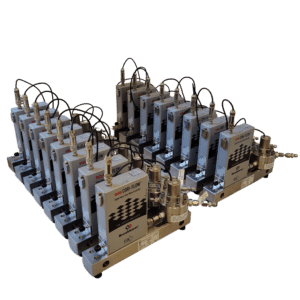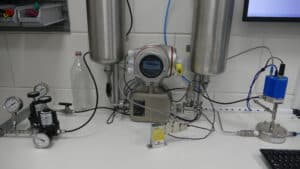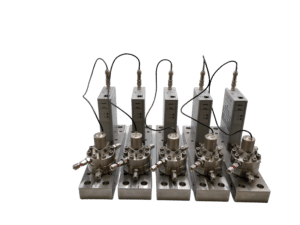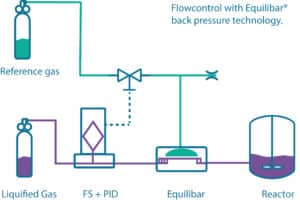Our Expertise: Flow Control
Precision Flow Control by PCS
Our precision flow control expertise is focused on lab, research, and pilot plant applications. When suitable for your process requirements, we supply you with high-quality, commonly available mass flow controllers; when your process requirements are more complex, we engineer tailor-made flow control solutions. Either way, we provide expert solutions that optimally fit your needs.
In research and pilot plants applications, process parameters are typically versatile or even unknown in the design phase. Therefore, you will often need – and benefit from – the exceptionally broad rangeability capabilities for flow control that we offer. We enable your installation to operate under a wide range of conditions and help you to push the boundaries of your application!
Flow control by PCS: What we offer
Below we highlight the most common measuring technologies. We offer experience and expertise in each of these, resulting in precision flow control solutions for any situation – no matter how straightforward or complex the application. We always select the technology that best fits your needs.
As processes in lab, research, and pilot plant settings are mostly engineered in pipe sizes between 1/32” up to 1” (from DN 0,8 to 25 mm), we offer expertise and products for precision flow control in the range from a few mln/minute up to 300 m3n/hour – covering both liquid and gas flows.
Thermal mass flow technology
A well-developed, reliable measuring method that has proven itself sufficiently: Thermal mass flow technology has been available in the market for 60+ years!
Most thermal mass flow sensors function by heating a small portion of gas in a by-pass and comparing the upstream gas temperature to the downstream gas temperature. When flow runs through the sensor, cold gas will cool the first sensor while the second sensor will see a higher temperature of the heated gas passing by. The operating principle of a thermal mass flow controller is excellently described in the animation video below.
Pros and cons of this technology
A significant advantage of thermal mass flow sensors is that instruments incorporating these sensors are generally quite robust. As a consequence, these devices can be used at higher pressures, even up to 700 bar.
Thermal mass flow sensor technology is mainly used for measuring gases.
As the measurement principle is mainly based on the heat capacity of the media and the heat capacity of most gases is adequately documented, the conversion factors between different media are generally well known. This means that the calculation of the flow rate is easy with this technology.
A thorough understanding of the properties of the actual gas that will be used is very useful in order to avoid calibration of the instrument with that actual gas (as calibration with the actual gas is not always possible). Because this technology has matured so much over the last 60 years, PCS can often predict with accuracy what the conversion factors will be between the calibration gas and the actual gas you plan to use.
Thermal liquid flow sensors are also available in the market but cover only flow ranges up to 0.5 kg/min.
An important consideration around the use of a thermal sensor is its fundamental speed of measurement: By its nature, thermal processes are relatively slow. This inevitably means that temperatures need to settle in the thermal sensor. Nevertheless, this sensor technology has matured to an extent where response times of less than 1 second are possible. In many common applications where stability is more important than control speed, this technology is perfectly adequate.
These faster response times do inevitably present limitations regarding the accuracy and stability of the measurement compared to the real flow. When accuracy and control speed are more critical than stability, other sensor technologies might be preferable.
[...]
The thermal sensor technology inevitably requires the mass flow controller to warm up before reaching its optimal accuracy. This warm-up time can be close to 30 minutes.
Thermal liquid flow sensors are available in the market but cover only flow ranges up to 0.5 kg/min.
For gases that are not well described or that have properties that vary heavily with temperature or pressure (for example liquified gases like CO2, ethane or propane), thermal sensor technology is also less suitable.
A Coriolis-type-sensor might be a better fit for some uncommon gasses and for liquids.
Delta-P-based mass flow technology
The +30-year-old Delta-P-based mass flow technology basically measures the pressure drop over a well-defined laminar flow element. This measurement is potentially much faster than the thermal sensor measurement, because pressure measurements require fundamentally less time. To convert the delta-P measurement into mass flow measurement, the controller also factors in other parameters like temperature and actual pressure. This requires computer power to ensure a quick and accurate measurement. Given the technical developments in computer technology over the past decades, this sensor technology has developed over time into a reasonably affordable and definitely fast yet accurate alternative.
Pros and cons of this technology
As this technology stands today, delta-P-based mass flow controllers outperform traditional thermal sensor instruments on speed, accuracy, rangeability, and control dynamics.
Thanks to the highly accurate pressure difference measurement, the measuring uncertainty is small. This results in a sensor accuracy of 0.5% of the reading or 0.1% of full scale.
Delta-P-based sensors also provide excellent repeatability of 0.1% of the reading and 0.02% of full scale. Applying this technology in flow control ensures for large control rangeability: Mass flow controllers incorporating these sensors can be used over a range of 1:200.
Delta-P-based sensors are capable of managing even more process variables. In addition to mass flow, they can be used to read out actual pressure, temperature and to calculate volume flow from these values.
Other than conventional thermal mass flow sensors, delta-P-based flow sensors have a warm-up time of less than one second. This results in optimal accuracy immediately after power-up.
On the basis of the measuring principle of delta-P-sensors, these mass flow controllers offer fast response times. These sensors are capable of updating the flow signal within less than 1 millisecond, allowing for fast PID-control-loops and resulting in fast and stable control.
Operating pressure is an important factor to consider when using instruments based on this sensor technology: Most devices will be rated at a maximum of 10 bar gauge.
Higher pressures may be possible, but as gas compression correlates with pressure increase, the pressure drop will become smaller at higher pressures, which will affect the accuracy of the mass flow measurement.
Coriolis mass flow technology
Coriolis measuring technology offers very effective, "true" mass flow measurement based on the measurement of vibrations of a tube, while fluids flow through the tube. This can be any fluid, either gas or liquid. This technology measures actual mass flow, as opposed to thermal or delta-P-based sensors, that in fact measure volume flow and return mass flow on the basis of conversion factors depending on the media used.
The Coriolis sensor signal is derived from the impulse force that is exercised on the tube by the media flowing through it, causing vibration based on the natural frequency of the media.
This media flowing through the Coriolis flowmeter is resistant to direction changes. When the media hits the wall of the (moving) tube, this resistance to change direction forces the tube to deform a tiny bit. This deformation results in a phase shift detected at the strategically placed pick-ups that measure the position of the tube. When the centre of the tube is exited in its own frequency, the strategically placed pick-ups register the timing of the vibration on other parts of the tube. The change in phase is a direct indicator of the mass flow through the sensor tube, so conversion factors are not needed to read out the mass flow.
Pros and cons of this technology
This type of mass flow measurement is independent of the media inside the Coriolis tube, which makes Coriolis sensor technology an effective technology to measure actual mass flow, without taking into account the fluid's characteristics.
As a result, Coriolis sensors can handle liquid, gases, supercritical media, and even mixed-phase media (provided the two phases are homogeneously distributed).
Coriolis flow meters provide the most accurate flow measurement. Accuracies of 0.1% of the reading are no exception!
Reading errors are minimized with a Coriolis sensor, and this technology also minimises the full-scale factor by zeroing the sensor under process conditions. This offset is possible thanks to the influence of the media (present in the sensor) on the vibration frequency of the Coriolis tube. Most Coriolis sensors have a zeroing procedure to this effect.
Coriolis sensors offer extremely high response times.
By measuring the shift in frequency, the sensor signal is extremely fast by design. Often filters are applied to smoothen the signal. The speed and accuracy of these sensors make them an ideal candidate for direct, closed-loop mass flow control.
Besides mass flow, Coriolis sensors can simultaneously measure density, temperature, volume flow and - in some cases - also the viscosity of the media. Because of this multitude of capabilities, incorporating Coriolis sensor technology results in a very versatile instrument!
The construction of a Coriolis sensor allows for designs that are suitable for very high pressures. Pressure ratings are common to go as high as 1.000 bar or 15.000 psi!
A potential downside of Coriolis sensors, could be the pressure drop over the sensor: To create enough velocity and impulse for accurate measurement, the tube size needs to be kept small. This inherently causes a pressure drop over the thus rather narrow measuring tube.
Manufacturers of Coriolis sensors often offer adequate modelling to calculate this pressure drop. When configuring a mass flow controller based on Coriolis technology, PCS turns this pressure drop into an advantage by combining Coriolis sensors with Equilibar dome-loaded control valves. You can read more about this in the Ultra Low Flow Control blog below.
Products for Flow Control
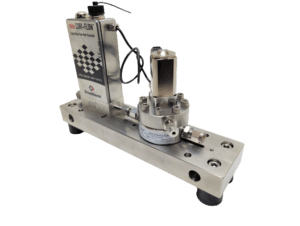
Precision Flow Controllers
Flow control valves designed & engineered by PCS for high precision flow control


